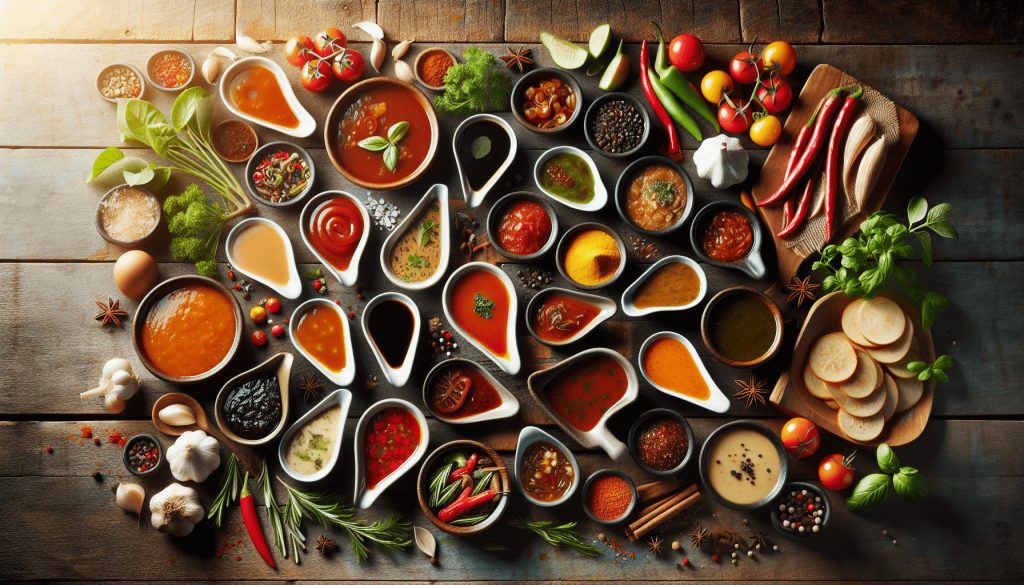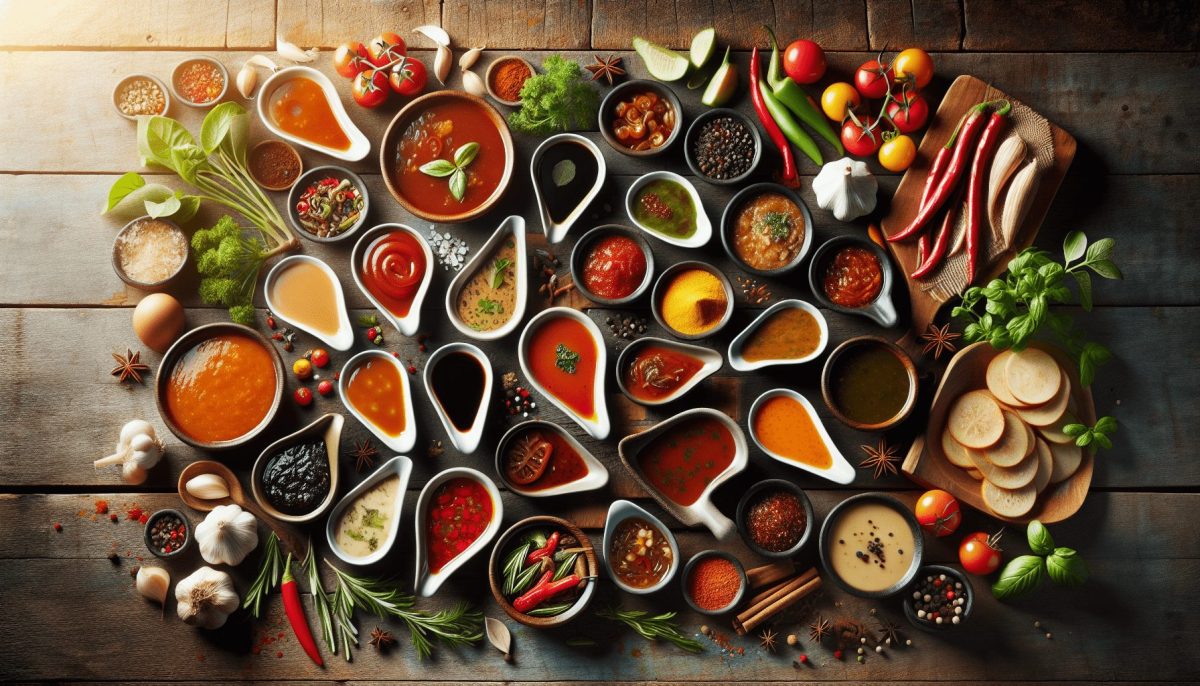Are you ready to spice up your taste buds? Look no further because we have something special just for you. Presenting “Delicious Hot Mother Sauces for Australian Palates,” a mouthwatering concoction of flavors tailored specifically for the Australian lifestyle. Whether you prefer a hint of heat or a fiery explosion of taste, these hot mother sauces are guaranteed to add a sizzle to your dishes. So, get ready to embark on a culinary journey like no other and discover the perfect sauce that will make your taste buds dance with delight. It’s time to ignite your palate and elevate your dining experience to new heights!

Understanding Mother Sauces
Definition and significance of mother sauces in culinary arts
Mother sauces are the foundation of traditional French cuisine and serve as the building blocks for numerous dishes. These sauces form the basis for countless recipes and are essential in creating depth and complexity of flavors. The significance of mother sauces lies in their ability to enhance and elevate dishes by providing a rich and flavorful base.
The five classical French mother sauces
The five classic French mother sauces are Béchamel, Espagnole, Hollandaise, Tomato, and Veloute. Each sauce has its unique characteristics and uses in various culinary applications. These sauces serve as the starting point for creating a wide range of other sauces by adding additional ingredients and seasonings.
Adaptation of mother sauces in different cuisines
While mother sauces originated in French cuisine, they have been adapted and incorporated into various culinary traditions around the world. Different cultures have put their spin on these sauces, infusing them with local flavors and ingredients. This cross-cultural adaptation showcases the versatility and adaptability of mother sauces, making them suitable for a range of international dishes.
Australian Food Scene
Overview of Australia’s rich culinary tradition
Australia is renowned for its diverse and vibrant food scene, which draws inspiration from its multicultural society. The country’s culinary tradition is a fusion of Indigenous Australian cuisine, British influences, and flavors from around the globe. Australian cuisine boasts a wide array of fresh seafood, rich meats, unique spices, and vibrant produce, making it a true gastronomic delight.
Influence of global cuisines on Australian food
Global cuisines have played a significant role in shaping Australian food culture. The influx of immigrants from various countries has led to the introduction of diverse flavors and cooking techniques. From Italian pasta and pizza to Asian stir-fries and curries, Australian cuisine embraces the best of international gastronomy.
Popularity of hot sauces among Australians
Australians have developed a love affair with spicy food, and hot sauces have become a staple in many households. The demand for hot sauces has skyrocketed in recent years, with an increasing number of Australians seeking out unique and fiery condiments to add a kick to their meals. The popularity of hot sauces is a testament to Australia’s evolving taste preferences and adventurous palates.
Adapting Mother Sauces for Australian Palates
Integrating Australian flavors into classic mother sauces
To cater to Australian palates and infuse local flavors into classic mother sauces, chefs and home cooks can experiment with incorporating traditional indigenous ingredients like macadamia nuts or bush tomatoes. These additions can create a unique depth of flavor and provide a distinct Australian twist to the sauces.
Using local Australian ingredients for a unique taste
Australia is blessed with an abundance of fresh, high-quality ingredients that can elevate the flavors of mother sauces. From seafood like prawns and barramundi to native herbs and spices like lemon myrtle or wattleseed, incorporating these local ingredients can add a distinctive taste profile to the sauces.
Adapting the spice level to suit Australian tastes
While some Australians have a penchant for fiery flavors, not everyone enjoys overly spicy food. It is essential to adapt the spice level in mother sauces to cater to a broader range of palates. Balancing heat with other flavors and incorporating milder spices can ensure that the sauces have wide appeal and can be enjoyed by individuals with varying tolerance to spiciness.
Béchamel Sauce: The Creamy Delight
Traditional preparation of Béchamel sauce
Béchamel sauce, also known as white sauce, is a classic mother sauce made with butter, flour, and milk. It is a creamy and smooth sauce that serves as the base for dishes like macaroni and cheese, lasagna, and gratins. The traditional preparation involves melting butter, adding flour to create a roux, and slowly whisking in milk until the sauce thickens.
Incorporating Australian flavors into Béchamel sauce
To give Béchamel sauce an Australian twist, consider adding ingredients like Tasmanian cheese or Australian truffles for a unique flavor profile. The richness of these ingredients complements the creaminess of the sauce and adds a distinct depth of flavor. Additionally, incorporating native herbs like lemon myrtle or bush spices can enhance the overall taste and make the sauce more representative of Australian cuisine.
Serving suggestions with Australian dishes
Béchamel sauce pairs exceptionally well with Australian favorites like meat pies, fisherman’s pie, or vegetable and cheese gratin. Its creamy texture and delicate flavor complement the robustness of these dishes, creating a harmonious culinary experience. Whether used as a filling or a topping, Béchamel sauce adds a touch of luxury and indulgence to Australian classics.

Espagnole Sauce: The Hearty Classic
Understanding the roots of Espagnole sauce
Espagnole sauce, also known as brown sauce, is a rich and hearty mother sauce made from brown stock and thickened with a roux. It is characterized by its deep, savory flavor and is commonly used in braised dishes and stews. The sauce has its origins in Spain but has become a significant component of French cuisine.
Creating an Australian version of Espagnole sauce
To create an Australian version of Espagnole sauce, consider using Australian red wine or adding a splash of indigenous ingredients like quandong or riberry. These additions can impart a unique and Australian flavor profile to the sauce, enhancing its richness and depth. Incorporating locally sourced meats and vegetables can further elevate the dish and make it a true celebration of Australian ingredients.
Popular Australian dishes to pair with Espagnole sauce
Espagnole sauce is the perfect companion for hearty Australian dishes like slow-cooked beef short ribs, kangaroo stew, or beef and Guinness pie. The robust flavor of the sauce complements the richness of these dishes, creating a harmonious combination of textures and tastes. Whether served over mashed potatoes or as a base for slow-cooked meats, Espagnole sauce adds a touch of warmth and comfort to Australian classics.
Hollandaise Sauce: The Rich Indulgence
The process of making Hollandaise sauce
Hollandaise sauce is a luscious and velvety emulsion made from egg yolks, butter, and lemon juice. It is a delicate sauce that requires careful preparation to achieve the perfect consistency and balance of flavors. The process involves whisking together egg yolks and lemon juice, followed by the slow addition of melted butter while continuously whisking until the sauce thickens.
Adding an Australian twist to Hollandaise sauce
To add an Australian twist to Hollandaise sauce, consider incorporating ingredients like finger limes or native lemon myrtle. These native citrus flavors can add a unique tang and zing to the sauce, enhancing its freshness and complexity. Additionally, substituting traditional butter with Australian macadamia nut oil can introduce a nutty richness to the sauce.
Ideal Australian meals to serve with Hollandaise sauce
Hollandaise sauce is a versatile accompaniment that elevates many Australian dishes. It is a classic pairing with eggs Benedict, providing a luxurious and indulgent element to the dish. Additionally, serving Hollandaise sauce with grilled seafood like barramundi or Moreton Bay bugs adds a touch of elegance and enhances the natural flavors of the delicately cooked proteins.
Tomato Sauce: The Tangy All-Rounder
Essence of a good Tomato sauce
A good tomato sauce is known for its tangy and robust flavor profile. It is made primarily from tomatoes, onions, garlic, and herbs, resulting in a versatile sauce that can be used as a base for various dishes. The key to a delicious tomato sauce lies in using high-quality ripe tomatoes and slow-cooking the sauce to allow the flavors to meld and develop.
Creating a uniquely Australian Tomato sauce
To create a uniquely Australian tomato sauce, consider incorporating indigenous ingredients like bush tomatoes or mountain pepper. These additions can add a distinctive depth of flavor and a touch of spice to the sauce. Experimenting with different varieties of native tomatoes can also create a more vibrant and complex tomato sauce that reflects the diversity of Australian produce.
Australian dishes that go well with Tomato sauce
Tomato sauce is a staple in Australian cuisine and pairs well with numerous dishes. It is a must-have condiment for Australian meat pies, sausages, hamburgers, and barbeque favorites. Its tangy and familiar taste acts as the perfect complement to these classic Australian dishes, elevating their flavors and providing a burst of freshness.
Veloute Sauce: The Light Elegance
Key characteristics of Veloute sauce
Veloute sauce is a light and elegant mother sauce made from a roux and a light stock, typically chicken or fish. It has a velvety texture and a delicate flavor that enhances the natural taste of the ingredients it accompanies. Veloute sauce is versatile and can be used as a base for creamy soups, seafood dishes, or poultry recipes.
Developing an Australian Veloute sauce
To develop an Australian Veloute sauce, consider using Australian chicken or seafood stock made from local ingredients. This can infuse the sauce with a deeper and more distinct flavor profile, enhancing its overall elegance. Incorporating native herbs and spices like lemon myrtle or saltbush can further elevate the taste and make the Veloute sauce a representation of Australian culinary heritage.
Typical Australian dishes served with Veloute sauce
Veloute sauce pairs beautifully with Australian dishes like grilled barramundi, chicken and mushroom pie, or crab bisque. The light and creamy nature of the sauce complements the delicate flavors of seafood and poultry, providing a harmonious balance. Whether used as a base for a soup or a sauce for a main course, Veloute sauce adds a touch of sophistication and refinement to Australian cuisine.
Creating Hot Variations of Mother Sauces
Adjusting the heat level in mother sauces
For those who enjoy a fiery kick, adjusting the heat level in mother sauces can be a perfect way to add excitement to dishes. By incorporating Australian hot peppers like habanero or ghost peppers, chefs and home cooks can elevate the heat to suit individual preferences. Balancing the heat with other flavors is crucial to maintain a well-rounded and enjoyable culinary experience.
Incorporating Australian hot peppers and spices
Australian cuisine is home to a variety of hot peppers and spices, which can be incorporated into mother sauces to create hot variations. From the vibrant heat of chili peppers to the robust smokiness of native spices like mountain pepper or bush tomato, these Australian ingredients can add complexity and depth to the sauces. Experimenting with different combinations and ratios of hot peppers and spices can result in unique and tantalizing flavors.
Trial and error: Balancing flavors for the perfect hot sauce
Creating the perfect hot sauce is often a journey of trial and error. It requires experimenting with different quantities of hot peppers, spices, and other flavor components to achieve a well-balanced and harmonious result. Tasting and adjusting along the way is essential to ensure that the heat does not overpower the other flavors and that the sauce remains enjoyable for the palate.
Storage and Preservation of Mother Sauces
Appropriate conditions for storing sauces
To ensure the longevity and quality of mother sauces, it is important to store them properly. Mother sauces should be stored in airtight containers in the refrigerator to prevent spoilage and maintain their freshness. It is crucial to cool the sauces completely before transferring them to storage containers to avoid the growth of bacteria.
Can and freeze: Methods of preserving sauces
Canning and freezing are effective methods for preserving mother sauces for an extended period. Canning involves sterilizing glass jars, filling them with the sauce, and then processing them in boiling water to create a vacuum seal. Freezing, on the other hand, requires portioning the sauce into freezer-safe containers or bags and ensuring they are tightly sealed to prevent freezer burn.
Shelf-life of homemade hot mother sauces
The shelf-life of homemade hot mother sauces, like any other homemade sauce, can vary depending on factors like the ingredients used, the storage conditions, and the absence of preservatives. As a general guideline, homemade sauces can be safely stored in the refrigerator for up to one week. However, it is always recommended to use your judgment and discard any sauce that shows signs of spoilage, such as an off odor or mold growth.
In conclusion, understanding mother sauces is essential for any culinary enthusiast looking to elevate their cooking skills. By adapting these sauces to suit the Australian palate and incorporating local flavors, it is possible to create a unique and delightful culinary experience. From creamy Béchamel to tangy Tomato sauce, hot variations, and the sophisticated elegance of Veloute, the possibilities are endless. Experimentation and creativity are key to mastering the art of mother sauces and creating tantalizing dishes that showcase the best of Australian cuisine.

Hey there, I’m Timothy, the passionate hot sauce enthusiast behind Boutique Hot Sauces. I founded this online boutique to share my love for artisanal hot sauces with fellow spice lovers across Australia. From small-batch to handcrafted, each sauce in my curated selection is chosen for its exceptional quality and unique flavour profile. I invite you to explore our diverse range, read our hot sauce reviews, and discover your new favourites. Let’s elevate your meals with a dash of fiery goodness together! With convenient delivery nationwide, your taste buds are in for a treat. Spice up your life with Boutique Hot Sauces today!
